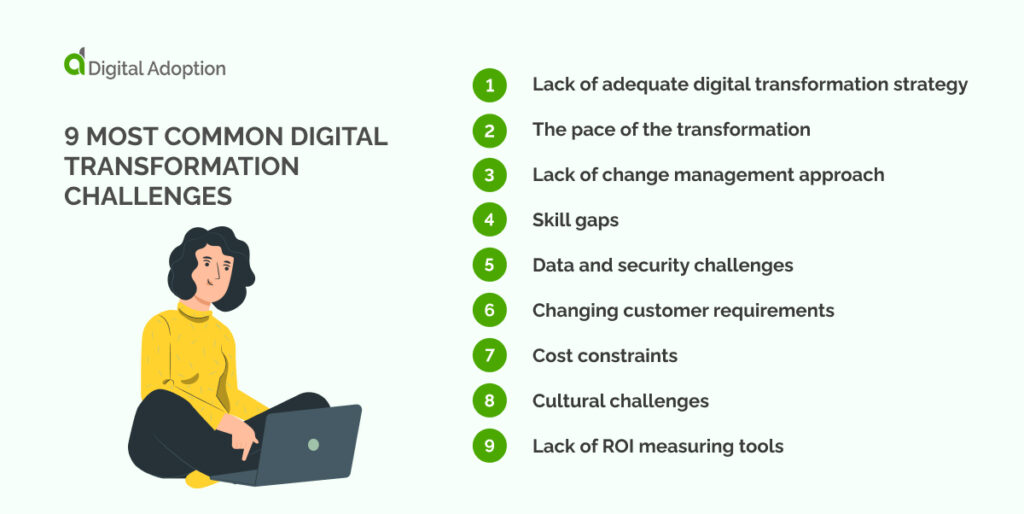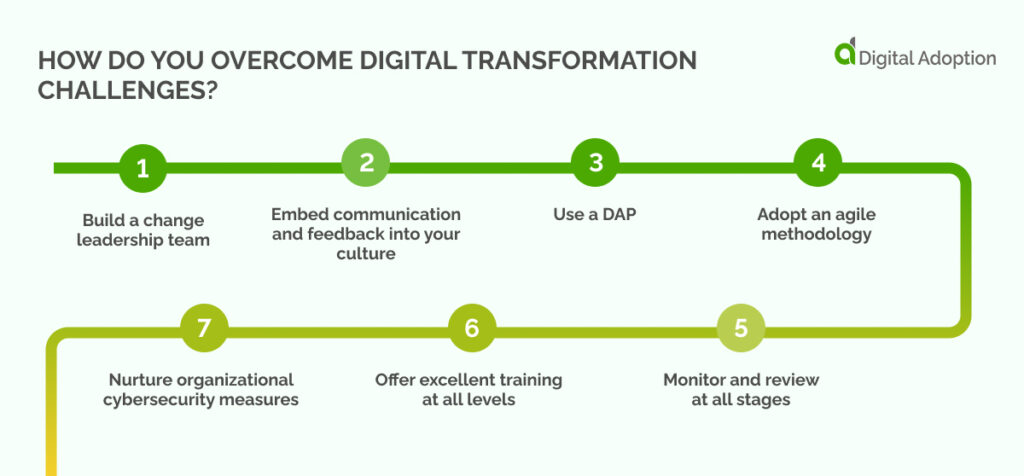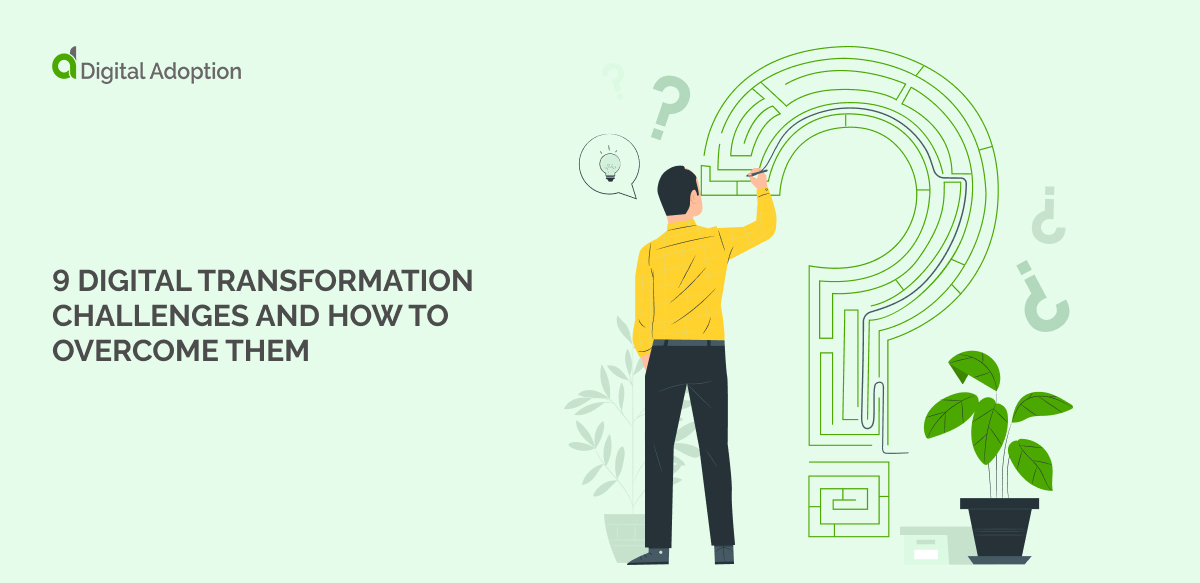Here we are in 2024, and enterprises are still struggling to overcome digital transformation challenges.
Predictions suggest that digital transformation technologies and services will reach $3.9 billion by 2027, so it’s still a real problem, and solutions to the obstacles to digital transformation are expensive.
The reasons for these challenges are vast, but they mostly include a poor digital employee experience, which results in low-grade digital adoption.
Staff often feel unsupported, and it is as if leaders do not explain changes or have no say in the changes their organization implements.
The challenges of digital transformation can impact roles differently. 18% of employees would consider departing their company due to a large organizational change. On the other hand, organizations fire 31% of CEOs for mismanaging change within a digital transformation.
But, all of these employee transformation challenges have negative impacts, so you should always strategize to avoid them if you want to come out on top.
This article will cover the nine most common digital transformation challenges and detailed explanations of how to overcome them.
By doing so, you will align your employees’ needs with the goals of your digital transformation strategy, leading to success, faster ROI, and higher year-on-year growth. If that sounds good, let’s begin!
9 most common digital transformation challenges

The only reassuring thing about obstacles to transformation success is that every enterprise has them.
We can use patterns to identify the nine most common challenges to successful digital transformation. The first is the lack of an adequate strategy.
- Lack of adequate digital transformation strategy
Addressing certain inquiries is crucial before initiating a digital transformation initiative.
Why replace outdated systems and manual procedures with modern digital counterparts? Does your organization possess a blueprint or urgency to integrate sophisticated systems? Are you adequately prepared to transition existing systems into new platforms?
These queries must be resolved beforehand. A successful transformation endeavor necessitates a digital transformation strategy.
Avoid falling prey to misguided presumptions and industry jargon. Instead, select from various digital transformation frameworks that align with your organization’s improvement opportunities and areas for enhancement.
- The pace of the transformation
The pace of transformation presents a significant challenge in digital transformation due to several factors.
Firstly, technological advancements occur rapidly, introducing new tools and methodologies that organizations must adopt to remain competitive. However, this pace can be daunting, especially for businesses with rigid structures and processes.
Moreover, the speed of transformation often outpaces employees’ ability to adapt, leading to resistance and reluctance to change. Your organization must invest in comprehensive training and change management strategies to facilitate smoother transitions.
Additionally, the fast-paced nature of digital transformation increases the risk of errors and oversights, particularly in rushed implementations. This approach can result in suboptimal outcomes or even project failures.
Overall, managing the pace of transformation requires careful planning, agile methodologies, and a proactive approach to stay ahead of technological advancements while ensuring employees feel adequately prepared to embrace change.
- Lack of change management approach
Organizations with a comprehensive change management strategy significantly increase their likelihood of meeting or surpassing digital transformation goals. Cultivating a robust change management culture is pivotal for organizational success, as the absence of such a strategy can jeopardize any new project or implementation plan.
A potent change management strategy entails meticulously planning projects by pinpointing underlying issues and fostering relationships with stakeholders and employees. Utilizing change management tools like Prosci’s ADKAR model can streamline this process.
ADKAR focuses on five key elements: Awareness of the need for change, Desire to participate and support the change, Knowledge of how to change, Ability to implement required skills and behaviors, and Reinforcement to sustain the change.
By leveraging such tools, organizations can effectively navigate the complexities of change and drive successful digital transformations.
- Skill gaps
As the rapid pace of technological advancement persists, businesses require personnel equipped with pertinent technical proficiencies.
Embracing digital innovations necessitates adeptness in contemporary technologies such as cloud computing, big data analytics, artificial intelligence, blockchain, and machine learning.
However, not all staff possess the requisite competencies to bolster digital transformation endeavors, and recruiting specialized talent each time a new technology emerges is impractical.
Consequently, digital adoption frameworks must prioritize ongoing education and training initiatives to give employees the adaptability to navigate evolving technologies.
- Data and security challenges
Data and security challenges are integral to digital transformation due to the increasing reliance on digital technologies and the vast amounts of data generated and processed.
Data integrity, confidentiality, and availability are crucial for maintaining trust and compliance, mitigating risks, and safeguarding against cyber threats.
Three examples of data and security best practices that can enhance transformation success include implementing robust encryption methods to protect sensitive data in transit and at rest, thereby preventing unauthorized access and data breaches.
adopting multi-factor authentication (MFA) mechanisms to strengthen access controls and verify users’ identities reduces the risk of unauthorized account access.
Conducting regular security assessments and audits to identify vulnerabilities, assess risks, and implement necessary measures enhances the organization’s overall security posture.
These best practices can help organizations strengthen their data and security measures, facilitate smoother digital transformations, and minimize potential disruptions.
- Changing customer requirements
Enterprises are in a perpetual state of change, a process hastened by the undeniable impact of COVID-19. Implementing digital transformation is no simple task, often requiring years of concerted effort.
It’s also essential to consider how customers perceive your brand and how it changes during a digital transformation. 86% of customers would consider quitting their connection with a brand they like after just one poor experience. So, it’s essential to consider rapidly changing customer needs within every transformation.
What occurs if your clientele’s demands shift on this journey? Such shifts are inevitable. Rather than being caught off guard, embrace a proactive approach and swiftly prepare to embrace emerging digital solutions.
- Cost constraints
Embarking on digital transformation entails significant financial investment. Without a robust transformation strategy, the insidious scope creep phenomenon can gradually extend deadlines and introduce additional tasks, escalating project costs.
When factoring in consultation fees, evolving customer requirements, or IT mishaps, the expense of digital transformation can soar.
It’s imperative to pinpoint your long-term objectives and the anticipated return on investment (ROI) from the transformation initiative. This approach enables you to discern excessive spending and identify opportunities to adjust your budget accordingly.
- Cultural challenges
Enterprises entrenched in legacy systems and manual workflows frequently exhibit a traditional mindset. Progress unfolds sluggishly, automation is met with skepticism, and the prospect of embracing novel technologies can be daunting.
Cultural shifts are a significant hurdle in digital transformation. Alignment across all levels, from leadership to fresh recruits, is paramount. Everyone must be willing to adapt their daily routines and embrace the process of acquiring new skills without trepidation.
- Lack of ROI measuring tools
Assessing the return on investment (ROI) for digital transformation is difficult. The benefits may not be clear or easy to measure, which can breed doubt and reluctance about future digital investments and hinder progress.
In contrast to conventional investments, the outcomes of digital transformation projects may not manifest immediately or be easily measurable.
Furthermore, the value generated from digital initiatives often transcends financial metrics, encompassing enhancements in customer experience, employee efficiency, and organizational agility.
This complexity in accurately gauging ROI can engender doubt and reluctance toward investing in forthcoming digital ventures, thereby stalling the advancement of digital transformation endeavors.
How do you overcome digital transformation challenges?

Now you understand each challenge. They are key to a successful transformation.
Let’s consider how to overcome these challenges. Understanding how to do so is crucial for successful adaptation. As technologies continually evolve, they make organizations more agile and help them remain competitive.
In a world that is rapidly becoming more digital, staying ahead of these changes is essential.
The first of these solutions is to begin your strategy with a change leadership team.
Build a change leadership team
Evaluate your current staff. Look for people who embody influence. They should also have innovation and reliability. Also, consider including individuals with transformational leadership experience.
Form a diverse team with these top achievers. They will be your transformative leadership team.
This team will lead the transformation. They will craft a vision for your digital journey that harmonizes with business objectives and is shaped by people who know your organization well.
This approach will help each department develop a cross-functional team philosophy toward collaboration.
This proactive strategy empowers organizations to prioritize the human element of change in digital transformation initiatives, thereby expediting the process.
Embed communication and feedback into your culture
Getting employee feedback and participation is invaluable for beating digital transformation hurdles. It builds a collaborative and committed workforce.
Engaging employees in the transformation journey and asking for their views helps organizations use their insights. It also helps them see obstacles and find better fixes.
Employees think that leadership listens to them. They think their contributions drive decision-making, so they are inclined to embrace and adjust to new methods and technology.
This ownership and dedication can speed up digital change. It makes an organization more flexible amid technological change.
Use a DAP
You must invest in a digital adoption platform (DAP). It is vital for the success of your digital transformation. Using a new digital app or process won’t make you efficient. To use them well, you must give employees or end-users good onboarding, training, and support.
The main features of a Digital Adoption Platform (DAP) include:
- Guided walkthroughs: They are interactive guides. They help users navigate through software or processes. These walkthroughs provide contextual assistance and help users complete tasks efficiently.
- Some DAPs have Smart Tips. These tips show on-screen prompts and tooltips to users as they use digital interfaces. The tips offer real-time guidance and support and improve user understanding and productivity.
- Analytics and insights: DAPs often provide in-depth insights into user behavior. They cover how features are usually adopted and how well they work. The analytics help organizations find usage patterns. They use them to optimize workflows and make data-driven decisions. These insights improve users’ digital experience.
Adopt an agile methodology
Admitting organizational vulnerability is key to digital transformation. Leaders know that innovation and adaptability are key. They are vital to thriving and helping to stay competitive in a digital world. However, technology evolves quickly, outpacing many people’s understanding.
Embracing agility entails embracing flexibility. It involves seizing opportunities as they emerge. Digital transformation shows agility. But adopting this ethos is crucial. Embrace new methods and tools. Don’t fear them. Be open to replacing old ways with new ones.
One example of an agile methodology is Scrum, which emphasizes iterative development, collaboration, and quick response to change.
Monitor and review at all stages
Digital transformation is ongoing. Setting up a framework to monitor, measure, and assess projects is vital.
This framework helps organizations find areas to improve. They can then make changes quickly. This proactive stance ensures that digital efforts fit business goals. They optimize their use of resources. It also helps to solve issues on time.
Consider integrating a QMS (quality management system) like MasterControl to streamline alignment with business objectives. Implementing total quality management with MasterControl’s QMS is seamless and offers robust functionality.
Ongoing monitoring and adaptation are key. They make digital transformation triumphant and lasting, allowing organizations to stay competitive. The landscape is swiftly evolving.
Offer excellent training at all levels
Training is essential at every organizational level. It is indispensable for surmounting digital transformation challenges.
Digital changes affect a company’s entire staff, from frontline staff to senior leaders. They need a full understanding of new technology and processes.
Secondly, training ensures that employees possess the skills to utilize digital tools effectively, maximizing efficiency and productivity.
Also, training fosters a culture of continuous learning. It empowers employees. It helps them to embrace change and innovation. It reduces resistance and fosters a more agile organization.
Also, training gives employees the knowledge to find and address roadblocks, making implementation and transitions smoother.
Lastly, training at all levels fosters alignment with organizational goals. It ensures everyone works towards a shared vision, which ultimately leads to more successful digital transformation.
Nurture organizational cybersecurity measures
Security is critical for many reasons. Nurturing an organization’s cybersecurity is key to overcoming digital transformation challenges.
First, businesses adopt new digital tech and processes. They then become more vulnerable to cyber threats. These include data breaches and cyber-attacks.
Improving cybersecurity safeguards protects sensitive information. It also reduces the risk of financial loss and reputational damage.
Strong cybersecurity also builds confidence. It fosters trust among customers and stakeholders, who trust the organization to protect their data. This trust is vital. It keeps relationships positive and business growing.
Also, good cybersecurity helps with regulation. It allows organizations to navigate data protection laws.
Organizations prioritizing cybersecurity can minimize disruptions caused by cyber incidents and maintain operational resilience.
Investing in cybersecurity is key to the success of digital transformation. It guards against threats. It ensures the smooth use of new tech.
To overcome digital transformation challenges, prioritize staff
If you want to overcome the difficulties of any transformation, look to your staff.
After all, team members are the ones involved in new tech. They also adapt to changes, not leaders.
Organizations can prioritize staff in this process by providing thorough training programs.
They can also do this by fostering a culture of innovation, collaboration, and staff involvement in decision-making.
Prioritizing staff yields positive outcomes. These outcomes include more engaged employees, improved morale and productivity, and better organizational agility.
These outcomes lead to better digital changes. They also bring higher ROI and a culture open to change.













